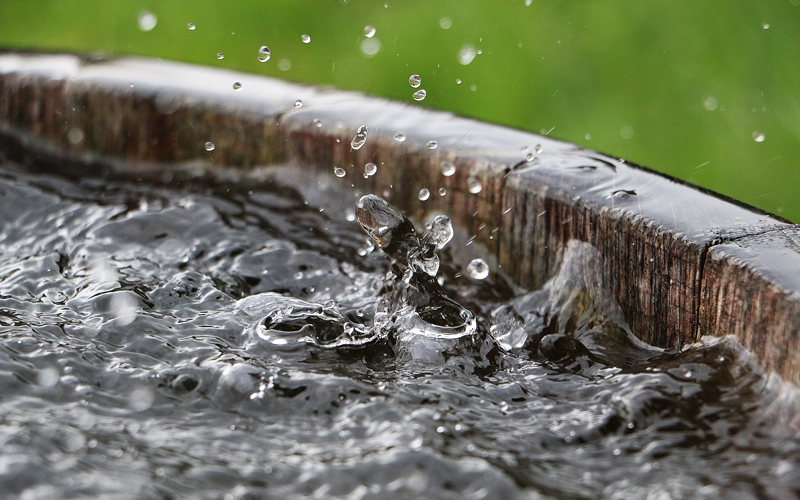
Rainwater harvesting systems adopted in new developments
The Association has previously printed articles highlighting the increasing pressure on drinking water arising from population growth, higher living standards and climate change. The same articles forecast widespread shortages unless approaches to water collection, storage and use are revised.
However, several new developments in the UK are pioneering water storage methods which seek to increase rainwater storage and re-use on-site. Not only will this reduce use of potable water, it will also tackle potential flooding events downstream – and permit additional use of rainwater water on gardens when most needed in summer.
Part of the water shortage problem in the UK has arisen from the affordability of drinking water. The relatively low-cost means drinking water is currently used for everything from car washing, toilets, filling hot tubs, showering and domestic washing. Whilst entirely legitimate, the current consumption of potable water for activities which do not require water of this quality is wasteful and no longer sustainable.
In 2020, the World Resources Institute reported domestic water demand grew by 600% between 1960 and 2014. Aside from a growth in population to contend with, resources are challenged by households that use more water than ever before. An average person uses 145 litres of drinking water per day, whilst the average household uses in the region of 349 litres per day.
In theory there are a range of solutions for stakeholders and particularly water companies to manage availability of water, but their implementation is not straightforward.
Since the forecast is for wetter winters, the most obvious solution is for water companies to increase storage capacity. However, construction of large reservoirs to capture and store additional water has historically been unpopular with the public, who regard use of land for large-scale water storage as wasteful (from a land use perspective) and an eyesore.
Use of existing water sources is another option. Groundwater provides approximately one third of water in England and makes an important contribution in Scotland and Wales. It is often used to bridge the supply gap left by the lack of rainfall, as well as sustaining rivers and wetlands during a drought. However, groundwater availability is subject to regional rainfall to recharge and, just like above ground resources, these have been notably absent in some areas.
Re-distribution of water supplies (from areas where there is a surplus to areas where the is a shortage) requires infrastructure which does not currently exist. De-salination is frequently flagged as an option in coastal areas, however, this method is energy intensive and at odds with low-carbon initiatives.
Increasing the cost of potable water for domestic and commercial users potentially penalises domestic users who are already struggling with energy costs and runs the risk of making commercial enterprises uneconomical to sustain – particularly during the summer months.
Commercial users of potable water such as plant nurseries are particularly vulnerable to both shortages of water and price increases. Protected and container crops grown on nurseries generally have less than 24 hours water reserves and, due to the density of crops, rain alone is not sufficient to sustain specimens. Modern peat-free mixes have a much higher requirement for watering frequency and demand, which wetting agents cannot fully compensate for.
Whilst landscape contractors’ reliance on water is seasonal, most of it is applied via sprinklers or a hose on a client’s site, with use subject to regional availability. Association members will recall during the 2022 temporary use (hosepipe) ban restrictions placed on water use by water companies were subject to considerable regional variation.
Recent research has revealed the potential benefits of rainwater harvesting systems for gardens of all scales, from small domestic plots to large public parks and gardens. Their potential exists in terms of not only helping to ensure gardens are self-sufficient during periods of low rainfall, but also their ability to support urban flood resilience.
A recent study focusing on five RHS gardens: (Bridgewater, Hyde Hall, Harlow Carr, Rosemoor and Wisley) assessed the hydrological viability of rainwater harvesting (RWH) to address irrigation demands within landscape and public gardens.
Most public gardens currently rely on a combination of public mains water and groundwater abstraction for irrigation. However, irrigation from these sources is often restricted during drought events and, given the likelihood of longer, more extreme drought events is predicted with a high level of confidence, alternative sources will be required to reduce the vulnerability of gardens in the future.
On a smaller scale, domestic users of mains water are also likely to face similar challenges; use of a hose pipe is one of the first activities temporarily banned during a drought event.
Whilst RWH potential varies widely due to differences in site characteristics, the presence of permeable and impermeable surfaces and climate variability, findings suggest harvested rainwater could provide a valuable additional water source for irrigation that could significantly reduce the vulnerability of nationally important gardens and visitor attractions due to abstraction restrictions in dry years. Similarly, domestic rainwater harvesting systems may also be installed to ensure homeowners can continue applying water with a hose throughout a temporary use ban.
A new development, Elmsbrook, in Cambridge, represents the first phase of an eco-town development in Bicester, which has been designed to create a net-zero community. Rainwater harvesting systems have been installed in over 300 properties, primarily for toilet flushing, which is estimated to reduce potable water use from 145 litres per day to 80 litres per day.
Eddington, Cambridgeshire, is the UK’s largest, site-wide water recycling system. Collected rainwater is used in buildings for washing machines toilet flushing and watering gardens. Re-use of rainwater for selected activities has reduced the site-wide demand for drinking water from 1,621,350 litres to 864,720 litres per day.
Both of these developments are examples of how rainwater harvesting systems have been implemented on a site-wide basis, but there are multiple options for landscape professionals to specify for their clients. The Association is fortunate to be home to several members who offer the complete suite of rainwater and irrigating services and has previously featured articles from Watermatic and Acco.
Further reading

